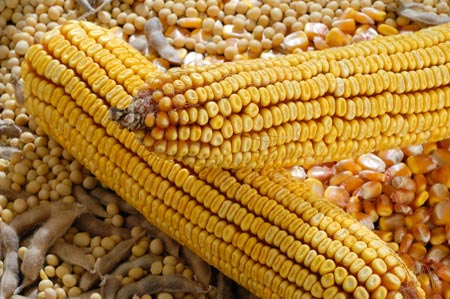 (Farm & Ranch Guide) – Soybeans were in abundance at the end of November – both in the U.S. and around the world.
(Farm & Ranch Guide) – Soybeans were in abundance at the end of November – both in the U.S. and around the world.
Demand will need to stay strong to use up the 2014/15 soybean crops.
In the most recent World Agricultural Supply and Demand Estimates report, U.S. 2014 soybean production was estimated at 3.958 billion bushels, with an ending stocks projection of 450 million bushels.
Global 2014/15 soybean production was projected at 11.465 billion bushels, with an ending stocks projection of 3.3 billion bushels.
On the CME Group exchange, soybean futures traded on Nov. 20 with the January contract at $10.22, March at $10.29, May at $10.36, July at $10.405, August at $10.38, September at $10.18, and November 2015 at $10.06 per bushel.
Compared with prices back on Nov. 6, January was 6 cents lower, March was 3 cents lower, May was unchanged, July was 1 cent higher, August was 2 cents higher, September was 8 cents higher, and November 2015 was unchanged.
The Nov. 20 export sales report indicated soybean sales of 487,500 metric tons (18 million bushels), which is lower than trade estimates and the recent sales pace. U.S. export sales reached 80 percent of the USDA forecast compared with a five-year average of 71 percent.
“There are some commercial contacts that are saying China – their appetite for soybeans has fallen off a cliff. They have a lot of soybeans coming in, and their crush margins are going lower, and that’s what we need to be watching,” said Frank LaPlaca, vice president of Futures International, Chicago. “I’m ‘bearish’ soybeans at these levels. I think farmers need to be pretty good about their marketing.”
The USDA has noted that farmers generally sell about 15 percent of their soybeans off the combine. In November, about 9 percent of the soybean crop is sold, and in December, farmers sell another 8 percent of the harvested soybeans.
“We still do have a tight pipeline,” LaPlaca said. “We still have crushers looking for soybeans, exporters looking for beans. We need to get the beans somehow, so you’re going to see basis come back in.”
At one western Minnesota elevator followed in this column, cash soybeans on Nov. 20 were $9.56 per bushel with a basis of 65 cents under. The price was 4 cents lower than back on Nov. 6, although the basis had narrowed by 3 cents.
As of mid-November, Brazil’s soybean crop was 63 percent planted, which is right on pace. The South American weather is cooperating enough, although U.S. farmers may want to follow along with professional crop progress reports as well as reports from friends and neighbors who travel to South America to see the soybean crop.
LaPlaca noted that Brazil’s Real has dropped in value, and the crops are traded in dollars. That means Brazil’s farmers have increased the amount of dollars their crop is worth.
“These farmers are seeing quite a bit of profitability on their soybeans and corn,” he said. “They have a little more change in their pocket because of the weakening of their currency.”




